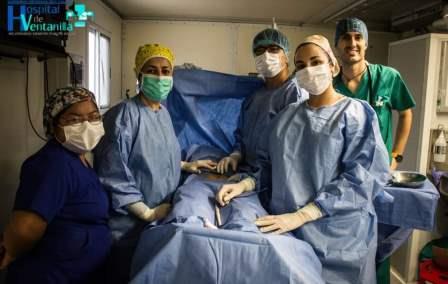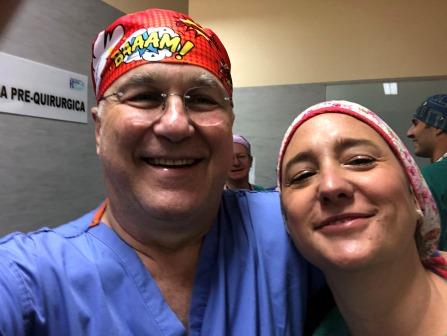VENTANILLA – International Humanitarian Hernia Mission. June 2019.
Ventanilla, Callao. Perú.

On the 8th of June 2019 a mission of the project Hernia International arrived into Lima Perú. The mission intended to visit for two weeks the Ventanilla District General Hospital. Ventanilla District is a densely populated community located at two hours drive from the city of Lima and belongs to the Province of El Callao. The population of Ventanilla is about 300.000 inhabitants.
The mission Ventanilla 2019 was sponsored by Fundación Cirujanos en Acción, www.cirujanosenaccion.com and Hernia International, www.herniainternational.org.uk
Volunteers of the Ventanilla Mission June 2019: The mission was composed of nine volunteers; five consultant surgeons, two consultant anaesthetists, and two theatre nurses.
– Rafael Chavez – Surgeon, UK
– Dominic Robert – Surgeon, Australia
– MaAngeles Torrico – Surgeon, Spain
– Celia Moreno – Surgeon, Spain
– Claudia Tinoco, Surgeon, Spain
– Eugenio Briz – Anaesthetist, Spain
– Vicente Cuquerella – Anaesthetist, Spain
– Mara Garcia – Scrub Nurse, Spain
– Natalia Rodriguez- Scrub Nurse, Spain

There was a very enthusiastic involvement of all staff in the hospital, including the Medical Director, Surgeons, anaesthetists, nurses, and all support staff. The local surgical team was led by Dr Ronald Medina and Dr Luis Bernaola, Consultant Surgeons.
Ventanilla Hospital is a Level II District General Hospital and has approximately 100 beds and 5 operating theatres. It is staffed with 6 anaesthethists and 17 professional scrub nurses. The Department of Surgery carries out conventional hernia surgery, biliary surgery, both laparoscopic and open; ano-rectal surgery and peripheral tumours.
Theatres:
The hospital has five operating theatres, clustered in a single surgical area. Four of those theatres were made available to the campaign, leaving one to cover their own emergency work in general surgery and Obs & Gynae.Of the four available theatres, two were standard, purpose-built theatres and the other two were small military, field-operating theatres that are coupled to the main building in a semi-permanent fashion.

Patient Population:
Patients were recruited at a national level. All recruited patients were assessed in advance and offered detailed information, consented and given instructions regarding preparation for surgery, including personal hygiene. As a result all patients that attended looked relaxed, well groomed and comfortable.All patients were clerked and admitted to the ward by the local interns and then transferred to the surgical area were they were re-examined by the surgeon, marked accordingly and had an opportunity to have a further conversation with the operating surgeon.
Anaesthetics were mostly spinal, a number of cases had their operations under local anaesthetics and all paediatric patients and those with large incisional hernias had general anaesthetics. The anaesthetic team were extremely keen and helpful.

The surgical trainees participated actively in all the surgeries.
Results
Surgery:
Number of procedures: 169
Inguinal: 57
Crural: 9
Incisional: 9
Umbilical: 76
Epigastric: 17
Spiegel: 1
Complications:
Follow up information is still pending. I shall report on that as soon as it is available.

Discussion of results
Observations, procedures and knowledge transfer throughout this mission
– Sterility in theatre – The operating theatres were kept in pristine clean conditions. The hospital staff kept excellent asepsia and antisepsia measures throughout the whole visit. The nursing staff were instrumental in keeping an impeccable theatre discipline and technique.
– Scrubbing: No brushes were available for scrubbing, only clorhexidine foam was utilised.
– Antiseptic preparation of the operative field: Only clorhexidine soap was utilised to prepare the operating area. A film of soap was normally left before draping and commencing the operation.
– Patient dignity
The local team were very pleasantly impressed by our uniform approach to patient’s dignity. They self-criticised the fact that they were less concerned with regards to keeping the surgical patients decently covered throughout the whole process, including examination, transferring to operating table, anaesthetics, surgery and postoperative management. The local team considered this an important learning point to take on board.
– Marking the operation side and site
The local team saw with interest our routine practice of marking the side of the operation at the time of preoperative examination and consent. They expect to adopt this safety technique.
– Preoperative morning briefing:
The local team normally undertakes a morning ward round to review the patients scheduled for surgery on the day, and for final pre-op indications.There were no morning briefings in the operating theatres during the campaign. Perhaps this should be implemented in subsequent missions

– WHO checklist Pre and postop:
The surgical team undertook the WHO checklist before and after each surgery. This is common practise in Ventanilla Hospital and the visiting volunteers kept this routine.
Communications
There were no visible telephone landlines in the clinical areas, however, communications were very effective thanks to the local team, which successfully ran the whole campaign on a Whatsapp platform.
Discussion with lectures from local professionals and from the visiting volunteers.
Opportunity for networking:
This mission was an opportunity for networking with our colleagues from Peru. As a result, we have been invited to conferences and congresses; at least two local doctors have shown interest in visiting our centres for training.
Case discussion Whatsapp group:
The local team has developed an international group, based on Whatsapp, for discussion of clinical cases of interest. This platform has remained very active.
Promoting presentation of results:
These report and results have been made in collaboration with the ventanilla team and we have suggested to the surgical residents that they may find material here for a presentation in a local or regional surgical conference.


